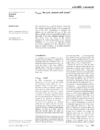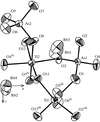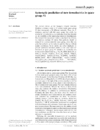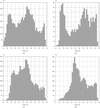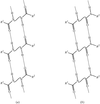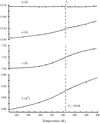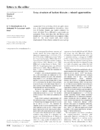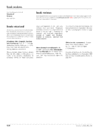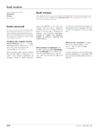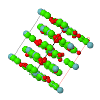issue contents
October 2000 issue

Cover illustration: Perspective view of the structure of the complex of 2,4,6-tris- (4-chlorophenoxy)-1,3,5-triazine with tribromobenzene, determined by neutron diffraction. Courtesy of J. A. K. Howard & C. K. Broder (University of Durham, UK), G. R. Desiraju, A. Nangia & R. K. R. Jetti (University of Hyderabad, India), C. C. Wilson & D. A. Keen (Rutherford Appleton Laboratory, Chilton, UK).
scientific comment
Neither of the common definitions of Uequiv yield a parameter of any great use, and its standard uncertainty is even more suspect. The need for a better `one-parameter' measure of the quality of a.d.p.'s is demonstrated.
research papers
The ordering of A and B atoms in b.c.c., f.c.c. or p.c. AxBy alloys and related compounds is restricted to a small number of thermodynamically stable structures. The structural units of these structures are assembled in different ratios for a variety of attractive or repulsive interactions.
Download citation


Download citation


The crystal structure of dehydrated CaA zeolite, solved using single-crystal synchrotron data, shows a disordered distribution of framework oxygen atoms and cations.
Download citation


Download citation


Hydrothermal investigations in the high-silica region of the K2O–Nd2O3–SiO2 system, carried out in a search for novel fast-ion conductors (FICs), yielded the new compound, K3NdSi7O17. Its structure is unusual in that it contains a symmetry-constrained Si—O—Si bond angle of 180°.
High-resolution electron-microscopy images of N-Nb2O5 reveal two different kinds of coherent twinning. The striking similarity between the observed electron-diffraction patterns for multiply twinned N-Nb2O5 and that reported for M-Nb2O5 can be understood by considering the similar block arrangements in the twin borders of N-Nb2O5 and the disordered M-Nb2O5.
Download citation


Download citation


An accurate synchrotron X-ray diffraction measurement of a single crystal of the RbTiOAsO4 compound shows that there is a substantial (dynamic and/or static) disorder of the Rb atoms over additional sites related by pseudosymmetry at room temperature.
A total of 21 structures reported in the Inorganic Crystal Structure Database under space group P3 satisfy the structural criteria for ferroelectricity. One of the remaining structures is a previously discovered ferroelectric, 19 are probably centrosymmetric and seven are polar but not ferroelectric.
Download citation


Download citation


The X-ray single-crystal structure and charge distribution analysis of synthetic YbFeMnO4 are reported. A vacancy of approximately 4% is present at the Yb octahedral site.
Download citation


Download citation


The structural details of (Sr0.13Ca0.87)2CoSi2O7, including the displacement of atoms, rotation and distortion of the structural units, and the partial ordering of the Sr and Ca atoms accompanied with the modulation have been determined. The structural discrepancies in (Sr0.13Ca0.87)2CoSi2O7 and in Ca2CoSi2O7 are discussed to find the effects of the partial substitution of Ca by Sr.
Download citation


Download citation


2,6-Dichloro- and 2,6-dibromobenzonitrile are isomorphous, with two half-molecules in the asymmetric unit of a monoclinic unit cell. The molecules pack in layers with a fourfold pseudosymmetry. The pseudosymmetry appears to be the consequence of halogen–halogen intermolecular interactions.
It is possible to understand, or at least rationalize, the occurrence of pseudosymmetry elements in some crystals as a consequence of a higher symmetry in a two-dimensional layer being obscured by the three-dimensional packing of the layers.
Download citation


Download citation


The packing of primary tartramides is driven by NH⋯O=C hydrogen bonds and supplemented by strong OH⋯O=C and weak NH⋯OH bonds, while in methylated derivatives OH⋯OH⋯O=C patterns dominate. Problems with the packing of methyl groups are overcome by changes in conformation (esters) or by co-crystallization with solvent water molecules (methylamides and dimethylamides).
The probabilities of occurrence of the 50 most common intramolecular hydrogen-bonded (N/O—H⋯O/N) ring motifs in the Cambridge Structural Database are presented and their implications discussed.
The hydrogen-bond networks and crystal packing arrangements of 81 secondary di- and polyamides in the Cambridge Structural Database are investigated. Graph-set analysis is used to identify and classify network motifs, which are rationalized in terms of the relative dispositions of the amide functional groups; symmetry relationships within and between hydrogen-bonded chains, ladders and sheets in the crystal packing are analysed.
Download citation


Download citation


The ring conformation transforms between sofa and dynamically disordered half-chair in the crystals of enolized 2-methyl-1,3-cyclohexanedione, C7H10O2. The transformation takes place at the continuous phase transition at Tc = 244 K.
Download citation


Download citation


The title compounds are all characterized by very short intermolecular O—H⋯O hydrogen bonds and C—N—O fragments in which the C—N and N—O bond lengths are almost equal. These observations are rationalized by means of database analysis and computational modelling.
Download citation


Download citation


The interplay between molecular conformation and supramolecular aggregation has been investigated in six 2-nitrophenyl disulfides and a 2-nitrophenyl thiosulfonate ester. Hydrogen bonds of the C—H⋯O type are responsible for observed conformations remote from the global energy minimum.
Download citation


Download citation


The title compounds are ferroelastic. There are H atoms in the structures, involved in asymmetric hydrogen bridges, which hop between donor and acceptor O atoms during the ferroelastic switching. The structure of n-pentylammonium dihydrogenphosphate (C5ADP) belongs to the same structure type as C3ADP and differs from C2ADP, C4ADP and C6ADP–C10ADP.
short communications
A model structure of a novel Zn–Mg–Dy compound is proposed based on electron diffraction and high-resolution transmission electron microscopy studies. Local atomic configurations in the structure are shown to be closely related to those in the Frank-Kasper type decagonal quasicrystal and in the Zn7Mg4 crystalline compound.
letters to the editor
Free 

The dispersion effects have been calculated for the structure factors of barium titanate. It is stressed that the Friedel pairs should be treated independently in the refinements.
books received
Free 

Free 

Free 



 journal menu
journal menu








